
From left to right: Anuradha Vikram, Joel Ferree, Nicole Hendrix, John Lopez, and Sarah Rosalena.
Last week, the board of ChatGPT-maker OpenAI fired its CEO, Sam Altman, only to reinstate him days later—an ouster/“inster” that left many questioning the leadership, safety risks, and oversight of the booming artificial intelligence ecosystem. This week, people called foul after Sports Illustrated published articles seemingly written by AI, and Merriam-Webster announced “authentic” as its 2023 Word of the Year, in part because of the rise of AI technology.
Last night, Zócalo, together with Arts for LA, ASU Narrative and Emerging Media Program, and LACMA, presented an evening asking the timely, urgent question: “Is AI the End of Creativity—Or a New Beginning?”
The event brought together a panel of creative workers and thinkers: LACMA’s Art + Technology Lab program director Joel Ferree, Concept Art Association co-founder and artist advocate Nicole Hendrix, Writers Guild of America AI working group member John Lopez, and interdisciplinary artist Sarah Rosalena. Curator, educator, and author of Use Me at Your Own Risk Anuradha Vikram moderated.
The panelists all agreed that AI technology could change the creative economy fundamentally, and offered takes on how artists might protect their work. The discussion touched upon the unique role artists have as critical thinkers in the face of expansive AI use, the opportunities AI presents for arts and entertainment, and ways that law and policy can ameliorate some of its risks.
But top of mind was AI’s effect on artists’ labor.
“We were acutely aware that we were the first labor negotiation happening in the age of AI,” Lopez said, speaking about this year’s Writers Guild of America strike and union members’ desire to instate meaningful regulation over AI. “No one was going to put rules or boundaries around this stuff if we didn’t speak up.” Discussions around AI were the toughest parts of the negotiations, he said. “This became the hill a lot of the studio negotiators were dying on.”
The fight, he said, is between the humanistic mission of arts and entertainment—“to facilitate communication … whether you’re writing a poem, you’re making a painting, or you’re writing a really dorky screenplay about talking dogs”—and the forces of industry.
Rosalena, who has been using AI in her own artwork, agreed, pointing to the extractive nature of AI models in taking artists’ work and creating other, AI-generated works from it—a value reproduced each time an artist’s original work is used in these processes. “I really admired the writers’ strike, and fully support people who truly understand the impact and how this could easily take over in an awful way.”
Hendrix grew concerned with AI companies’ tools like ChatGPT and large-scale visual databases when she started poking around in the repositories and found her own husband’s artwork, as well as images created by friends and colleagues, posted without permission. “The thought that their work was scraped without their consent, credit, or compensation—and that’s the foundation a lot of these models are built upon—just didn’t sit well with us.”
“What is most upsetting about all of this is the job replacement,” she said, citing examples of gaming studios in Texas letting go of their art departments, businesses contracting advertising agencies using AI-generated images in lieu of designers, and independent producers coming to meetings with pitch decks full of AI images. “Job loss is here, and it’s only going to continue to grow.”
Hendrix noted, too, a recent AI-generated Cosmopolitan cover. “A model … the photographer, the hair and makeup artists, the person that pulled the fashion, the wardrobe—all of these artists and true art and collaboration [are] replaced by one AI image. It’s a two-dimensional flat version of what art is, when art has so much depth, humanity, and soul.”
AI devaluing creative work and labor is an even bigger concern for younger artists who now must compete with AI as well as established creatives to rise in the field, Lopez said.
“But [AI] also takes your portfolio and makes you compete against your own portfolio for a job,” Hendrix pointed out.
So, what is the artist’s role in all of this?
“Artists really need to be aware and extra critical of images,” Rosalena urged.
Ferree empathically agreed: As a curator with sway over purse strings, he seeks to nurture projects that engage or critique technologies like AI. “Artists are probably the best people to engage with emerging technologies because they can be critical,” he said. “As these tools become more commonplace … The role of a curator becomes even more important, the same way a librarian is going to have a pretty big fight ahead of them. Because you are fighting for the sake of art history, for the sake of information itself.”
What do we need to do, then, to protect ourselves? asked Vikram.
Ferree wondered about using technology, such as blockchain-based watermarks or NFTs, to protect artists’ assets. Perhaps some form of digital registry could provide a record when an artwork is used somewhere else.
“What a lot of people found out, the hard way,” Vikram responded, “is that an NFT is not actually a legally enforceable contract.” In the online world, they added, people are abusing the idea of fair use and taking copyrighted material without permission. They are hoping to profit while the courts figure it out, they said.
Hendrix mentioned two defensive web apps that people can use to help their work evade algorithms contributing to AI databases—Glaze and NightShade. Hendrix’s organization has held town halls with the U.S. Copyright Office, and raised money to lobby on behalf of individual creators.
Throughout the evening, the online audience participated via a chat that was visible to the in-person audience and panelists. While most panelists spoke of artists fighting against AI, one online guest thought that AI could open up the art world’s gatekeeping practices. Another wondered if there was room for ethical AI in creative practice.
At the heart of the conversation were questions about our very humanity.
“We already have a lot of things in this world pushing against human connection,” Lopez said. “[AI] is not about human expression, but about amalgamating a whole bunch of people’s prior expressions and putting it into a data blender.”
“As artists, we are the bearers of humanity,” Rosalena said.
And, wrapping up the conversation, Vikram said, “AI is nothing without us. Human beings still call the shots. And let’s keep it that way.”





Send A Letter To the Editors